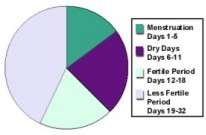Understanding Your Reproductive System
It is actually quite surprising how difficult it can be to fall pregnant. In fact, most specialists will only see couples who have been trying to conceive for more than a year. The female body is only fertile for a few days of every menstrual cycle, and if your timing is not absolutely spot on, you will miss the chance and have to wait for that time when you are fertile during the following cycle. There are, of course, other factors which affect your ability to successfully conceive, including your age and the type of lifestyle that you live.
The best way to fall pregnant is to have a basic understanding of the female reproductive system, ovulation, when you are most fertile and what factors may be preventing you from falling pregnant.
Ovulation and the Female Reproductive System
It is a good idea to understand the female reproductive system in order to help you see how important timing is during your monthly cycle. Let’s just make sure that we all understand exactly what is happening when you go through your monthly cycle.
The female reproductive system is made up of many different organs, each playing their own vital role in reproduction.
- uterus : the uterus is centered between your hips, just above where the top of your pubic hair ends. It is roughly the size and shape of an upside-down pear. Each month it prepares a soft spongy lining in case an egg is fertilized.
- fallopian tubes : you’ve got two of these, and they lead off from each side of the uterus and link it to the ovaries. The tubes are about the width of a hairbrush bristle and 4-5 inches long. They have finger-like “fimbria” at the ovary ends, which help waft eggs towards the womb.
- ovaries : there are two of these too - one on the end of each fallopian tube. If you put your hands on your hips (on them - not above them), your fingers are probably just over your ovaries. They are about thumbnail in size. Ovaries are full of eggs (ovum) from the day you’re born - up to a million of them. Each egg is surrounded by a group of cells called follicles. Follicles are fluid-filled sacs on the ovaries that enlarge as eggs ripen. Each follicle contains an immature egg.
- vagina : the muscular passage between the vulva and cervix.
- cervix : the lower opening of the uterus.
- vulva : the external “lips” of your vagina - officially referred to as ‘female genitalia.’
Ovulation and Timing Your Baby’s Conception
Conceiving successfully relies more on correct timing than just the act of intercourse, so therefore it is of utmost importance that you understand when you are going to ovulate as this is your most fertile time. There are different ways of determining your most fertile days in your cycle.
If you have a normal menstrual cycle, it will be easier for you to determine your most fertile days. Lets take a look at a regular 28-day cycle for example. 
As you can see from the diagram on the right, we take the beginning of each cycle from the first day that you start menstruating. This is important to remember when you are calculating when you are going to ovulate. If for example you take the beginning of your cycle from the last day of menstruation, you will be way off target right from the beginning.
Your most fertile days will be days 12-18 during your cycle. This means that between the 12th and 18th day of your cycle, you are going to ovulate. Okay, so now you know when you are going to be at your most fertile, so your next question would be, when is the best time to have intercourse in order to improve the chances of conceiving?
The best time to have intercourse in order to improve chances of conception would be from days 10-18. Why day 10 if you will only be becoming more fertile between days 12-18? Well let me explain the reasoning behind this theory.
This is because the male sperm will survive for up to 72 hours once released. So to have a fair chance at conceiving should you ovulate on the 12th day of your cycle, you should start having intercourse from day 10, instead of day 12. If you wish to determine exactly when you are most fertile, there are many tests to help you.
Revision date: June 11, 2011
Last revised: by Dave R. Roger, M.D.